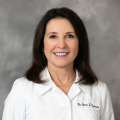For almost 50 years, UCLA’s Mobile Eye Clinic has provided free eye care services to Los Angeles-area elementary schools. Over time, the ophthalmologists began noticing a predominance of astigmatism in preschoolers. This didn’t come as a surprise.
“There’s a tsunami of refractive errors (mainly nearsightedness) currently happening in Asia and the United States,” says Anne L. Coleman, MD, PhD. She is professor and chair of the Department of Ophthalmology at the Stein Eye Institute, David Geffen School of Medicine at UCLA.
The UCLA Stein Eye Institute wanted to explore the intricacies behind astigmatism in young children in California. So they did a study on children in Los Angeles ages 3 to 5. The trial took place from 2012 to 2017, and their findings were published in October 2024 in Ophthalmic Epidemiology.
Clinic enables ‘largest of its kind’ study
In 1975, an anonymous donor funded UCLA’s Mobile Eye Clinic. The clinic’s mission was to reach medically vulnerable communities.
“That donor made a huge difference,” says Dr. Coleman. “Since then, we’ve screened more than 400,000 individuals.” Initially, first graders in Los Angeles County schools were screened by the UCLA Mobile Eye Clinic. During this service outreach, the ophthalmologists noticed some trends. Among them, “We found that Hispanic children had astigmatism that didn’t decrease as much with age, whereas in other populations, it did,” explains Dr. Coleman.
Astigmatism is an imperfection in the eye’s curvature that results in blurred vision. It's common for babies to have astigmatism, which usually corrects on its own.
With a grant from First 5 Los Angeles (F5LA), the UCLA Preschool Vision Program (UPVP) kicked off and sought to investigate the incidence of astigmatism and other refractive errors (vision issues that generally can be fixed with glasses) in preschoolers. From 2012 to 2017, UPVP performed 93,097 free vision screenings – one of the largest studies of its kind.
New technology that eliminated the need for standard eye charts enabled the UPVP team to screen up to 100 children a day in preschools and Head Start programs. A child looks ahead for a second or two, and the machine quickly assesses their eye’s refractive error.
“If it had been 10 years earlier, we might not have been able to accomplish this, because there was no instrument that would’ve given us an accurate refraction,” Dr. Coleman says of the study’s timing.
If an issue is identified during the procedure, a child has a complete pediatric ophthalmology examination. Through F5LA, the impacted children were given free eyeglasses. With the conclusion of the UPVP grant, Essilor, an ophthalmic lens manufacturer, has stepped in to provide free eyeglasses through its outreach program.
J. Benjamin Margines, MD, MHCI, a former Stein Eye resident and current vitreoretinal (specializing in the retina and vitreous body of the eye) fellow at UC Irvine, oversaw data from the UPVP.
"We knew astigmatism decreased as kids aged, but what was not known were the variance in how it decreased for different races and ethnicities," he says of one component of the study. What did the team learn?
“We saw decreases in astigmatism between the ages of three and four, with a main decrease between ages four and five, but we found that these changes happen at different times for different races and ethnicities, and Latino children in particular just seemed to keep having astigmatism,” he says. “We know that hyperopia, or farsightedness, increases mostly between the ages of four and seven, but less is known about changes in astigmatism in this age cohort. To be able to correlate that with astigmatism and important growth changes happening between these ages might have clinical or screening significance.”
Theories from the study
That the UPVP results show an astigmatism problem, especially among preschool-aged Latino children, raises questions that can serve as a springboard for other potential research and studies.
Dr. Coleman says one theory suggests certain children being exposed to near activities — such as computer games and reading — versus play is a possibility.
She also points to a study that found that kids attending a school closer to a playground or park had less myopia, or nearsightedness, due to spending time outdoors. This may also affect the development of astigmatism in these children.
Seeing that ‘the trees have leaves’
Testing preschoolers helps safeguard against amblyopia. This is a condition where the brain doesn’t fully process information because it never receives visual input.
Long-term issues of amblyopia include:
- Difficulty getting a driver’s license
- Not seeing objects as quickly when walking
- An increased risk of falling
- Inability to see clearly even with the correct eyeglasses
A delay in addressing amblyopia can result in a lifelong loss of vision sharpness. “The neural connections in the brain don’t develop correctly, so even with glasses, someone’s opportunity to have 20/20 or 20/15 vision is lost forever,” Dr. Margines says.
“When things are blurry, the brain fills in the blank spots,” Dr. Coleman explains. Once children are wearing the correct eyeglasses, we have heard them say “Wow, the trees have leaves; before, I saw a big green blob,’” Dr. Coleman recalls. Without treatment for amblyopia, those children as adults may never see the leaves on trees, even with the correct eyeglasses.
Though the UPVP study is over, the UCLA Mobile Eye Clinic is still going strong. “Our main focus is to continue screening preschoolers,” says Dr. Coleman.
And, with the knowledge revealed by the study, Dr. Margines says, “The Latino population is more susceptible to astigmatism, but as long as screenings occur, we’re going to catch the problem.”




